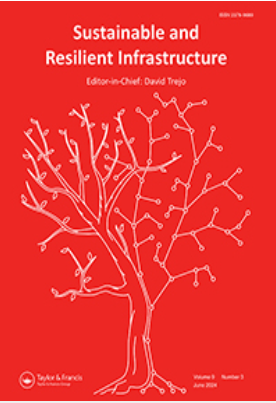使用不同改造策略的基础设施管理的全生命周期成本弹性优化框架
IF 2.2
Q2 ENGINEERING, CIVIL
引用次数: 0
摘要
摘要:全生命周期成本(LCC)和恢复力指数是基础设施在其使用寿命期间对灾害事件进行管理的有价值的指标。在本研究中,提出的多目标框架为决策者选择最优改造策略提供了一种系统的方法,使LCC最小化,同时满足给定的弹性水平,从而选择各种改造策略。对于每种情况,通过IDA建立易损性曲线,用于计算恢复力和LCC,其中包含了先前危险事件多次发生引起的损伤条件的完全或不完全修复行为的影响。本研究采用著名的“NSGA II”来确定最优解决方案集。本文以炼油厂的实际结构为例,对优化改造策略的各个方面进行了深入的研究和讨论。关键词:生命周期成本弹性、多目标优化框架、改造策略、基础设施管理致谢作者衷心感谢匿名审稿人对论文的认真阅读、深刻的建议和评论。披露声明作者未报告潜在的利益冲突。作者简介:pedram Omidian是Tarbiat Modares大学地震工程专业的博士生。他的研究兴趣包括生命周期成本、恢复力和危害管理。nas KhajiProf。Naser Khaji是广岛大学基础设施管理实验室的首席研究员。他的研究兴趣包括各种基础设施的健康监测,土-结构-流体相互作用,计算结构动力学和地震波传播,结构动力学和地震工程的逆问题,计算力学的数值方法,地震危害分析。本文章由计算机程序翻译,如有差异,请以英文原文为准。
A total life-cycle cost–resilience optimization framework for infrastructures management using different retrofit strategies
ABSTRACTEach of the total Life-Cycle Cost (LCC) and resilience index are valuable indicators of infrastructure management against hazard events during its service lifetime. In this study, the proposed multi-objective framework provides a systematic methodology for decision-makers to select the optimal retrofit strategies that minimize the LCC while satisfying a given level of resilience, for which various retrofit strategies are chosen. For each case, the fragility curves are established through IDA for calculating the resilience and LCC, which incorporates the effects of complete or incomplete repair actions of damage conditions induced by multiple occurrences of previous hazard events. This study employs a well-known ‘NSGA II’ to identify the optimal set of solutions. The various aspects of the optimal retrofit strategies are thoroughly investigated and discussed for an actual structure in the refinery sites as a case study infrastructure.KEYWORDS: Life-cycle costresiliencemulti-objective optimization frameworkretrofit strategiesinfrastructures management AcknowledgmentsThe authors would like to sincerely appreciate anonymous reviewers for the careful reading, insightful suggestions, and comments contributed to their paper.Disclosure statementNo potential conflict of interest was reported by the authors.Additional informationNotes on contributorsPedram OmidianPedram Omidian is a doctoral student in Earthquake Engineering at Tarbiat Modares University. His research interests include life-cycle cost, resilience, and hazard management.Naser KhajiProf. Naser Khaji is the Principal Investigator of the Infrastructure Management laboratory at Hiroshima University. His research interests include health monitoring of various infrastructures, soil-structure-fluid interaction, computational structural dynamics and seismic wave propagation, inverse problems in structural dynamics and earthquake engineering, numerical methods in computational mechanics, and seismic hazard analysis.
求助全文
通过发布文献求助,成功后即可免费获取论文全文。
去求助
来源期刊

Sustainable and Resilient Infrastructure
ENGINEERING, CIVIL-
CiteScore
7.60
自引率
10.20%
发文量
34
期刊介绍:
Sustainable and Resilient Infrastructure is an interdisciplinary journal that focuses on the sustainable development of resilient communities.
Sustainability is defined in relation to the ability of infrastructure to address the needs of the present without sacrificing the ability of future generations to meet their needs. Resilience is considered in relation to both natural hazards (like earthquakes, tsunami, hurricanes, cyclones, tornado, flooding and drought) and anthropogenic hazards (like human errors and malevolent attacks.) Resilience is taken to depend both on the performance of the built and modified natural environment and on the contextual characteristics of social, economic and political institutions. Sustainability and resilience are considered both for physical and non-physical infrastructure.
 求助内容:
求助内容: 应助结果提醒方式:
应助结果提醒方式:


